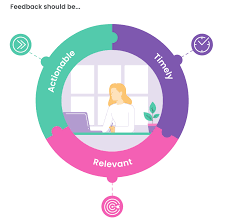Feedback is the key to approaching any learning outcome and hence integral to the system of education. However, more often than not, the focus remains on alphanumeric grades as a form of feedback, when in reality, they are far from being the most effective method of providing or receiving feedback.
As Cam Brooks and John Hattie explain (Cam Brooks, Robyn M. Gillies, Annemaree Carroll, John Hattie) “it is the quality rather than the quantity of feedback that is vital for feedback to be received and used by the learner”. Grades, therefore, serve as a quantifiable mechanism within a given context, but cannot be taken as an effective, standalone tool for augmenting student learning outcomes. On the other hand, qualitative feedback provided at every step of the learning process ensures scaffolding for a student to achieve the desired outcome.
In providing a conceptual framework for effective feedback John Hattie (Hattie and Temperley, 2007) has divided it into three steps - feeding up, feedback back and feeding forward. The three steps embody three key considerations in a student’s mind - ‘where am I going?’(feeding up); ‘How am I going’? (feeding back) and ‘Where to next?’ (feeding forward). The second step has been further segmented into four levels - task, process, self-regulatory and self.
It’s important to remember that the true effectiveness of feedback lies in how it is received rather than how it is given. While we all acknowledge that we need feedback to grow, we can actually end up feeling confused if the feedback is too soft or indirect, or getting defensive if the feedback is overly critical or direct. This is where clarity and contextualisation help in maximising feedback efficacy and efficiency.
So, how can you make the feedback effective? Here are a few steps you can look at:
- Set the context and solicit response on whether the reviewee is willing to receive the feedback. Ensure that the feedback is provided within the learning period rather than after the learning period, so that it can be implemented.
- Provide evidence or data points within a particular context that clearly define the feedback instead of being generic, ie. “It was a great presentation”; try to mention exactly why you thought the presentation was great.
- Clearly state the impact of the evidence or data points that are presented.
- End the process with a student-led query so that a commitment can be made to reinforce positive behavior (in the case of positive feedback) or partake in corrective actions (in the case of an opportunity for improvement).
While most instructors are comfortable with providing feedback in an offline capacity, challenges have arisen when ensuring effective and timely feedback in the pivot to online delivery. At the core, we need to ensure that a two-way feedback loop is maintained:
- Students need feedback to understand how well they have achieved their learning objectives
- Instructors or educators need feedback to understand the effectiveness of their instructional design and content delivery.
How do we ensure that we are completing this cycle of feedback that leads to the creation of a formative learning experience for the academic community? There are several tools that may help our education community in ensuring a smooth flow of feedback, and adapt to online modes of operation.
For instance, the instructor-friendly features of Turnitin Feedback Studio play a key role in supporting a formative learning environment for students. Instructors can harness QuickMarks - a library of feedback that can be quickly applied to multiple students across multiple classes and assignments, plus rubrics, grades, and even voice feedback, for every student assignment.
The Assignment Statistics of the Gradescope assessment platform can provide real-time, actionable insights for instructors in understanding what their students have learned (or not learned). Equipped with per-question and per-rubric item analytics, instructors can use these data-driven insights to evaluate if their mode of instruction or content needs to be revised or reinforced.
Furthermore, Turnitin Draft Coach is a student-centred tool that teaches students to become more independent learners and confident writers. By supplying instant feedback where and when they write, students can self-correct any issues around citation/references, address unintended plagiarism before submission of their work (thereby reducing instructor workload), and improve their English language skills.
With the right intent and the right tools in place, institutions can ensure an effective feedback cycle that flourishes in any online or offline learning environment.



